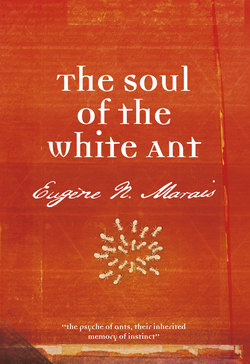Читать книгу The Soul of the White Ant - Eugène N. Marais - Страница 3
На сайте Литреса книга снята с продажи.
ОглавлениеTranslator’s Preface
The name of Eugène N. Marais is known to all Afrikaans-speaking South Africans as a writer of short stories and verse. He himself, however, would wish to be remembered for his lifelong study of termites and apes. He began life after leaving college as a journalist, then studied medicine for four years, but eventually took up law and was called to the Bar by the Inner Temple. A scholar and a man of culture, he chose nevertheless to live for a period extending over many years in a “rondhavel” or hut in the lonely Waterberg mountains, learning to know and make friends with a troop of wild baboons, whose behaviour he wished to study. He tamed them to such a degree that he could move among them and handle them with impunity. At the same time he busied himself with the other end of the chain and studied termite life, a study which often meant tremendous drudgery and needed endless patience.
During those years Eugène Marais was not concerned with publicity in any form, but a friend induced him to write an article for an Afrikaans periodical called Die Huisgenoot. This proved so popular that the author was besieged for more, and the articles continued for almost two years.
His years of unceasing work on the veld led Eugène Marais to formulate his theory that the individual nest of the termites is similar in every respect to the organism of an animal, workers and soldiers resembling red and white blood corpuscles, the fungus gardens the digestive organs, the queen functioning as the brain, and the sexual flight being in every respect analogous to the escape of spermatozoa and ova.
About six years after these articles appeared, Maurice Maeterlinck published his book, The Life of the White Ant, in which he describes this organic unity of the termitary and compares it with the human body. This theory aroused great interest at the time and was generally accepted as an original one formulated by Maeterlinck. The fact that an unknown South African observer had developed the theory after many years of indefatigable labour was not generally known in Europe. Excerpts from Marais’ articles had, however, appeared in both the Belgian and the French press at the time of their publication in South Africa. Indeed, the original Afrikaans articles would have been intelligible to any Fleming, for Afrikaans and Flemish are very similar.
No one who reads this book, based on the articles published so many years earlier than Maeterlinck’s book, will hesitate to give its author the honour due to him.
Eugène Marais intended writing a fuller and more scientific volume, but this intention was frustrated by his untimely death.
Winifred de Kok
